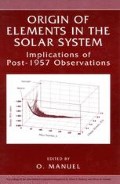Abstract
The solar system is just one sample, though of course the most thoroughly studied sample, of cosmic chemistry. Some perspective on it can be gained from an overview of the chemical evolution of the Galaxy and Universe, how our knowledge of this evolution has developed, and what problems remain to be solved. The very long-range future, comparable with the age of the universe, is also potentially of interest.
Access this chapter
Tax calculation will be finalised at checkout
Purchases are for personal use only
Preview
Unable to display preview. Download preview PDF.
References
Baade, W.: 1944a, “The resolution of Messier 32, NGC 205, and the central region of the Andromeda Nebula”, Ap. J. 100, 137–146.
Baade, W.: 1944b, “NGC 147 and NGC 185, two new members of the local group of galaxies”, Ap. J. 100, 147–150.
Burbidge, E.M., Burbidge, G.R., Fowler, W.A. and Hoyle, H. (B2FH): 1957, “Synthesis of the elements in stars”, Rev. Mod. Phys. 29, 547–650.
Cameron, A.G.W.: 1957, “Stellar evolution, nuclear astrophysics and nucleogenesis”, Chalk River Report CRL-41; “Nuclear reactions in stars and nucleogenesis”, Publ. Astron. Soc. Pacific 69, 201–222.
Eggen, O.J., Lynden-Bell, D. and Sandage, A.R.: 1962, “Evidence from the motions of old stars that the galaxy collapsed”, Ap. J. 136, 748–766.
Payne, C.H.: 1925, Stellar Atmospheres; A Contribution to the Observational Study of High Temperature in the Reversing Layers of Stars, Harvard Observatory Monographs, No. 1, Cambridge, MA, 215 pp
Tinsley, B.M.: 1968, “Evolution of the stars and gas in galaxies”, Ap. J. 151, 547–565.
Trimble, V.: 1975, “The origin and abundances of the chemical elements”, Rev. Mod. Phys. 47, 877–976.
Trimble, V.: 1991, “The origin and abundances of the chemical elements”, Astron. Astrophys. Rev. 3, 1–46.
Trimble, V.: 1996, “Cosmic abundances: Past, present, and future”, in Cosmic Abundances: Past, Present and Future, eds., Holt, S.S. and Sonneborn, G., Astron. Soc. Pacific Conf. Ser. 99, pp. 3–35.
Author information
Authors and Affiliations
Editor information
Editors and Affiliations
Rights and permissions
Copyright information
© 2002 Kluwer Academic Publishers
About this chapter
Cite this chapter
Trimble, V. (2002). Chemical Evolution Tomorrow. In: Manuel, O. (eds) Origin of Elements in the Solar System. Springer, Boston, MA. https://doi.org/10.1007/0-306-46927-8_15
Download citation
DOI: https://doi.org/10.1007/0-306-46927-8_15
Publisher Name: Springer, Boston, MA
Print ISBN: 978-0-306-46562-8
Online ISBN: 978-0-306-46927-5
eBook Packages: Springer Book Archive

